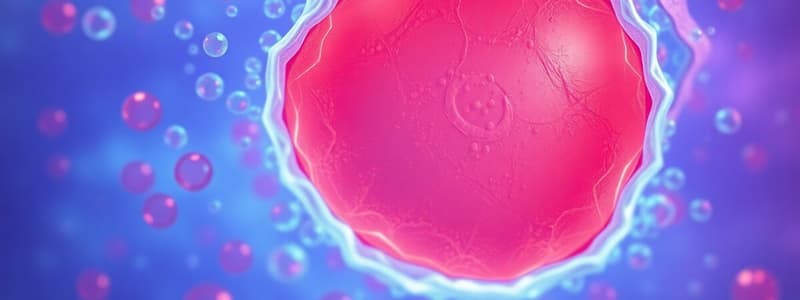Podcast
Questions and Answers
What is the primary function of simple cuboidal epithelium?
What is the primary function of simple cuboidal epithelium?
- Protection from abrasion
- Filtration and diffusion
- Transportation of nutrients
- Secretion and absorption (correct)
Ciliated simple columnar epithelium is specialized for absorption of nutrients.
Ciliated simple columnar epithelium is specialized for absorption of nutrients.
False (B)
What type of epithelium lines blood vessels?
What type of epithelium lines blood vessels?
Endothelium
Simple squamous epithelium is specialized for __________ and __________ of body fluids.
Simple squamous epithelium is specialized for __________ and __________ of body fluids.
Which type of epithelium has cilia that help in moving mucus?
Which type of epithelium has cilia that help in moving mucus?
The superficial layer of cells in stratified squamous epithelium can be __________ off.
The superficial layer of cells in stratified squamous epithelium can be __________ off.
Match the following types of epithelium with their primary functions:
Match the following types of epithelium with their primary functions:
Keratinized stratified squamous epithelium covers the body as part of the epidermis.
Keratinized stratified squamous epithelium covers the body as part of the epidermis.
Flashcards are hidden until you start studying
Study Notes
Surface Epithelium
- Functions as the body's protective covering and lining.
Simple Squamous Epithelium
- Specializes in filtration of body fluids and diffusion of nutrients and gases.
- Endothelium: lines blood vessels.
- Mesothelium: forms the epithelial layer of serous membranes.
Simple Cuboidal Epithelium
- Specialized for secretion of hormones and absorption of water and solutes.
- Commonly found lining kidney tubules and in the thyroid gland.
Non-Ciliated Simple Columnar Epithelium
- Specializes in secretion of mucus and absorption of nutrients.
- Contains goblet cells and gastrointestinal cells equipped with microvilli.
Ciliated Simple Columnar Epithelium
- Features cilia on the apical surface to move mucus produced by goblet cells.
- Provides protection from invasion and reduces fluid loss.
- Located in bronchioles and oviducts.
Non-Ciliated Pseudostratified Columnar Epithelium
- Nuclei at varying depths create a stratified appearance.
- Specializes in absorption and secretion of substances such as saliva.
- Lines the epididymis and part of the male urethra.
Ciliated Pseudostratified Columnar Epithelium
- Equipped with cilia to sweep mucus across the tissue surface.
- Offers protection from invasion.
- Predominantly lines the upper respiratory tract.
Stratified Squamous Epithelium
- May be keratinized; superficial cells can be sloughed off to protect underlying tissues.
- Keratin is a filamentous, insoluble protein that imparts mechanical strength and integrity.
- Functions as a protective layer against abrasion, fluid loss, UV radiation, and invasion.
- Nonkeratinized type lines the vagina; keratinized type forms the outer layer of the epidermis.
Stratified Cuboidal Epithelium
- Rare type of epithelium.
- Protects ducts and tubes from abrasion.
- Found in sweat glands, esophageal glands, and parts of the male urethra.
Stratified Columnar Epithelium
- Provides protection from invasion and secretion, such as tears.
- Examples include esophageal glands and parts of the conjunctiva in the eye.
Transitional Epithelium (Urothelium)
- Appears cuboidal when at rest; appears squamous when stretched.
- Lines hollow organs that expand to accommodate fluids.
- Commonly found in the urinary bladder, ureters, and urethra.
Studying That Suits You
Use AI to generate personalized quizzes and flashcards to suit your learning preferences.




